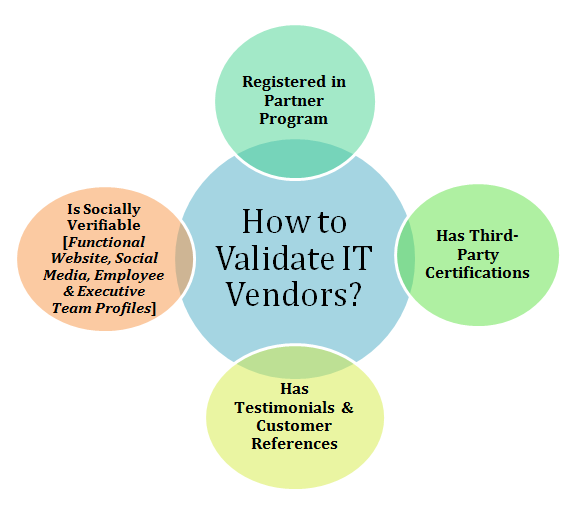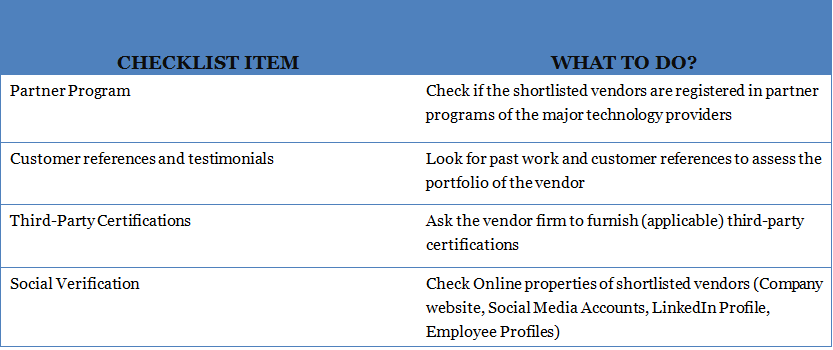How to validate the shortlisted IT vendors? [Vendor Management Series: Part 2]
This is the second post in our IT Vendor Management Series. The first was “3 Step Guide to Selecting B2B IT Vendors“. Once selected, the next step is to shortlist the vendors with whom you will want to set up a lasting relationship for acquiring development, maintenance, and support services.
Stick to the following four steps for assessing the vendor’s competency.
- PARTNER PROGRAMS
Validate the credentials of vendors after you are done with the ‘vendor search’ process. A good starting point is to verify that whether or not the vendor is registered in a partner program. Major vendors have registered Partner Programs. Gold, Silver, and Platinum are the most common partnership programs of major technology providers. Further classification is done according to the technology area and competence of partners. Major categories of competencies are:
- Application Development
- Application Integration
- Software Asset Management
- Project & Portfolio Management
- Small & Midmarket Cloud Solutions
- Intelligent Systems
- ERP
You can check the partner programs attended by vendors’ resource persons by surfing through the vendor’s profile.
- THIRD PARTY CERTIFICATIONS
Third party certifications are also a good source to validate vendor competency. Industry, technology and social accolades also highlight the relevancy and competency of the vendor. ITIL (Information Technology Infrastructure Library) is a set of practices for IT service management. Currently, the ISO/IEC 20000 is the industry relevant certification that lends credence to an IT service provider’s operations.
- CUSTOMER REFERENCES AND TESTIMONIALS
Testimonials from past and current customers are also a valid proof of a vendor’s skill-set, competency and project delivery capability. References of past work and customers can also give you an idea about the competency of the vendor. You can even ask the potential vendors to provide the reference of the most recent project/s accomplished by the vendor.
Free assignments and project demo are also useful in assessing the quality of work and how the vendor completes the given tasks.
- SOCIAL VERIFICATION
Online properties of vendor such as company websites, LinkedIn profile, Twitter feed, and employee profiles can also help to develop a holistic picture about the vendor.
If the potential vendor resides in your home country, use the following methods to verify the vendor credentials.
- Verify the vendor’s tax information using the publicly available documents. Use Taxpayer Identification Number Form (W-9) Requirement
- Public domain searches
- Ask a third party firm to verify telephone, email and postal addresses of the vendor
Your IT vendor should be able to save you time and money in the three important areas i.e. development, services and support. Other than technical expertise of the vendor, the willingness of the vendor to understand your problem, business context and future goals should also play an important role in your decision criteria for selecting the IT vendor. Often, IT vendors and their resource persons work with customers’ teams. As an IT project manager you should also assess the soft-signs of a vendor’s compatibility with your company. Shortlist vendors that are flexible in presenting alternatives to cut cost and deployment time. Mostly the project’s development and service requirements are flexible and need to change according to the business requirements. The vendor should be able to service your requirements in an agile and prompt manner.
RECAP
As discussed in 3 Step Guide to Selecting B2B IT Vendors, IT project managers should use a method for selecting IT vendors that are flexible yet methodological. Since you may have to repeat the process, in case the first attempt does not deliver results, adopting a repeatable method helps in selecting the right B2B IT vendor. Here’s a recap of the post.








